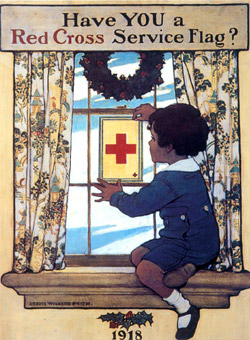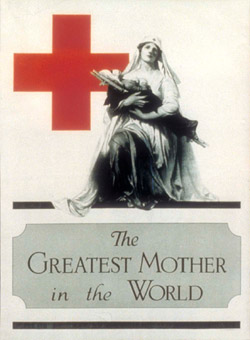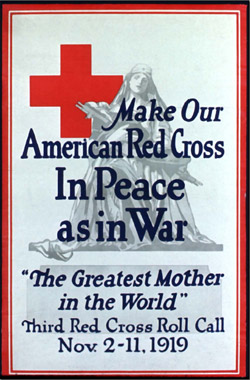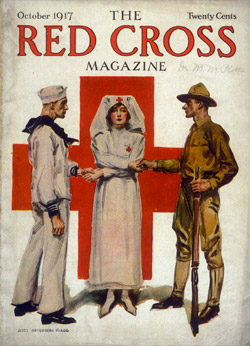Rallying a Nation: Red Cross During WW I
Rallying a Nation: American Red Cross Advertising During World War I

During WW I, the American Red Cross faced an unprecedented national need for its service. Raising the funds to deliver this service required that the organization use advertising to appeal directly to the American people. The American Red Cross used every possible means of publicity, most of which the organization had never before employed, to encourage donations and volunteers. When time was of the essence, the American Red Cross assembled an advertising campaign that proved to be extremely effective.
The War Fund and Roll Call Campaigns
The National Headquarters of the American Red Cross led two fundraising initiatives: the War Fund and the Roll Call campaigns. Taking place in June of 1917 and May of 1918, the two War Fund drives sought donations for the relief effort abroad. Advertising for these campaigns detailed the uses of current funds and made an appeal for donations to provide a higher level of service. In total, the War Funds brought in about $250M, significantly surpassing the organization’s expectations.
The Roll Calls, initiated in 1917, occurred annually around Christmastime for 25 years. The Roll Calls’ main purpose was to generate funds by asking the public to join the membership list and pay a $1 due. This initiative was instrumental in raising millions for the organization. Running ads with slogans such as, “We cannot all serve in the trenches, but we can all serve at home,” Red Cross members increased from 286,000 to 20 million in just two years. This level of success in a relief campaign had never been achieved in American Red Cross history.
Campaign Components
The American Red Cross was able to conquer unfamiliar ground as well as solidify some of its previous advertising techniques with WW I campaigns. The success of these campaigns lied primarily in the organization’s two-part strategy. First, the National Headquarters created the instructions, models, and products for the campaign, distributing them to all its local chapters. With these tools, the American Red Cross chapters undertook a dynamic campaign unique to their respective communities. This aggressive and extensive endeavor was the first of its kind in the organization’s advertising history. The campaign included:
- Posters – Posters represented one of the most compelling and popular components of the campaign. Some of the most common themes included: “The Greatest Mother in the World,” “All you need is a heart and a dollar,” and “Keep this hand of mercy at its work.”
- Newspapers, magazines – As the American Red Cross upheld its policy of not paying for advertisements, countless newspapers and businesses generously provided public service advertising support. Publicity also came from the multitude of articles written in magazines and newspapers covering the campaign and its success.
- Banners, billboards, placards – The American Red Cross slogan was seen everywhere, in places such as restaurant menus, theatre and movie programs, and even homes; the “Red Cross Service Flag” was a popular memento given to all members to be displayed in their windows.
- Brochures, leaflets – Literature was provided to the public outlining the work of the American Red Cross and emphasizing the dire need of the troops abroad. It called for donations, membership support and volunteers at local chapters.
- Motion pictures – Films were created and distributed to all movie houses, along with lantern slides that were displayed between movies. These short films provided moving visuals to encourage support for the American Red Cross.
- Public speakers – One of the most avid speakers for the Red Cross was President Woodrow Wilson, who was known to make public pleas for Americans to support the organization. Local leaders, such as preachers, were encouraged to make mention of the Red Cross’s efforts, as well. People called “4-Minute-Men” gave pre-written speeches in theaters and movie houses asking for support.
- Public events – Volunteer-run “Enrollment Booths,” found on streets corners at all hours, were used to solicit subscribers to the organization, while some local communities organized parades and pageants.
Campaign Success
In the face of a historic demand for help, the American Red Cross used every possible method of reaching the public through advertising. Through national, as well as grass roots, efforts, the organization rallied the nation to help support the war effort.
The American Red Cross’s record of achievement during WWI secured the organization’s position as a trust-worthy partner in times of need. The organization gave people a vehicle through which they could unite to help their troops, and demonstrate their dedication to the US and to winning the war. Today, the American Red Cross continues to serve as a conduit for the generosity of the American spirit in its relief efforts.
Print Ads
Christmas

Flag

Greatest Mother

Hand of Mercy

In Peace

Magazine cover

American Red Cross
Copyright © 2005. All rights reserved.






